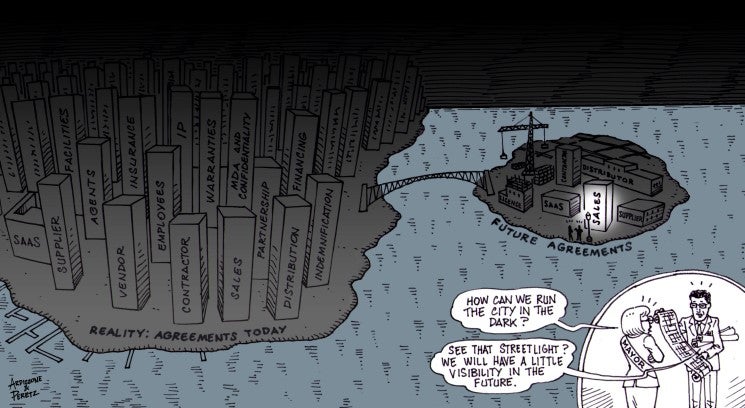
As an in-house attorney, you are at the heart of all of your company’s business relationships: clients, supplier, contractors, partners, vendors, landlords, financiers, distributors, and more. You likely participate in contract review and drafting or editing of documents that define the contours of many of these relationships.
What happens to all these agreements after signing? For most companies, these agreements are soon forgotten: abandoned in in-boxes, shared drives, and file cabinets. If this reminds you of your own company, you are not alone. The Gartner Group, which studies corporate use of technology, determined that for large enterprises (those with more than 1,000 employees), 65 percent have no system to manage their contracts or the obligations therein. As an attorney, you know what’s in those agreements and what is really lost: the guardrails and responsibilities for all the company’s business relationships.
For medium-sized companies (those with 100 to 1,000 employees), a full 80 percent have no system for managing their contracts or the obligations therein, and for small companies (those with less than 100 employees), 99 percent lack any such system, according to the Gartner Group's research. And a Corporate Legal Operations Consortium (CLOC) Survey revealed that even among the most sophisticated large corporate law departments (entities with a median of US$7 billion in revenue), nearly half had no contract management system, which means they are missing key operating instructions for their relationships with suppliers, customers, and partners.
For the minority of organizations which have built or purchased some type of database for storing and annotating their contracts, they are often still far from identifying and extracting all of the knowledge from their existing agreements because databases need data to be extracted from contracts and inputted into such a database before it can provide business insights.
An in-house attorney at a large educational organization told me how they had spent US$1 million on a database for contract information, yet it was useless because no one loaded any data. It was the classic database problem of NINO: Nothing-In, Nothing-Out.
This widespread corporate blindspot about the key terms of each company’s business relationships creates a real opportunity for you, as in-house counsel, to increase your stature and contribution if you have the right perspective and approach. First, think more holistically about what a contract represents. For the individual attorney stuck in a narrow view of his or her own silo, a contract is simply another document to engineer, mark up, and put away.
However, if you want a seat at the executive decision-making table, you need to think about contracts differently. The lawyer may be the handmaiden of the contract, but the real stakeholders in the contract are the company’s various business departments.
Contracts represent the guardrails, goals, and promises of the relationship between your organization and nearly every entity with which it does business. Every department of your company is impacted by contracts on a daily basis: What do we have to deliver? How much will we get paid and on what terms? What is our risk exposure in each relationship? Who do need to refrain from recruiting to enforce a non-solicitation? When can we change suppliers? When should I call my customers to upsell? These are the core business questions for the senior team in your company. If you follow the right steps, you can leverage your insight in contracts to become an integral part of this strategic business decision-making process.
[Related: 5 Strategies for Intentional Relationship Building — The Social Way to Succeed]
The most important first step is to decide where to focus your efforts. The answer: Target your existing business relationships. These relationships represent the data you need to drive your business right now.
Sure, you can try to be more organized about data gathering in the future. But that is not going to get you a seat at the table because it doesn’t yield actionable information this year, and possibly not even next year. In any given year, you might replace five percent of your company’s contracts with new ones.
Thus, even if you are scrupulously organized in capturing all the key data from these future agreements, you are still 95 percent blind. To earn a spot at the executive table, you need the wide field of vision that can only come from your existing agreements, not the five percent of new agreements you will make next year.
Another common technology mistake that limits attorneys to an individual “siloed” contributor role is an over-reliance on templates. Yes, templates are great for drafting contracts faster. But your salesperson may have made concessions and modifications specific to a client to get the deal done. Many companies think they know the key terms of their sales agreements until the customer tries to take advantage of its special terms and your company’s operations team is caught flat-footed. And your templates will change over time.
The result is that you mistakenly think all your agreements match a particular template, and then receive a rude surprise when your auditors or regulators or customers discover otherwise. At the end of the day, you need to know what was actually agreed to in each customer relationship, regardless of which version of the template was presented to the client and how it was modified to close the deal.
The more significant limitation of trying to run a dynamic business using a static work process like a template was highlighted many years ago by Ralph Waldo Emerson: “A foolish consistency is the hobgoblin of little minds.” Templates provide consistency but they work only when you are the one drafting the contract — which generally applies only to sales agreements, and perhaps some non-disclosure agreements.
Templates are far less applicable to agreements with suppliers, partners, distributors, licensors, financiers, landlords, vendors, and SaaS providers, because each of these counterparties is likely to draft the contract rather than rely on your form. Relying on a few data points typed into your form sales contracts alone, while being blind to all terms of your other business relationships, is not going to give you the broad perspective that your company expects from its top executives.
Successfully managing a business is reminiscent of how to successfully guide your own inner spiritual life: Be present now and invest in understanding the perspective of others. For in-house attorneys, this means focusing your efforts and investments on understanding the business agreements you already have in place, as well as deciphering and recording business terms beyond your own, one-size-fits-some sales agreements templates. It is this broad perspective and present focus that leads to business enlightenment and can move you from a siloed individual contributor role to a key member of the executive team steering the entire business.




